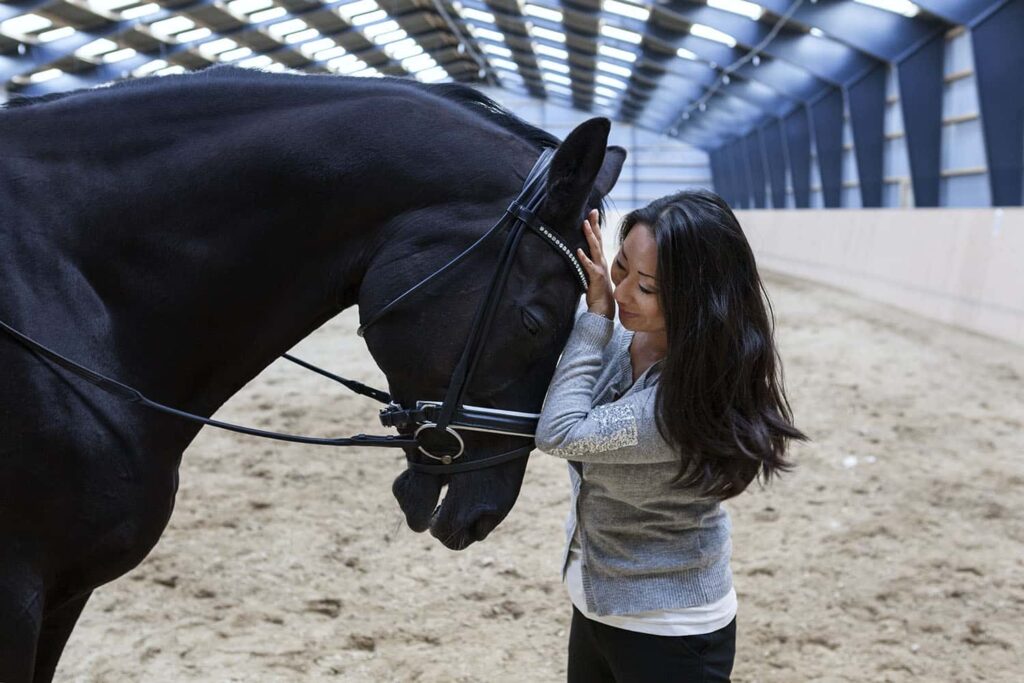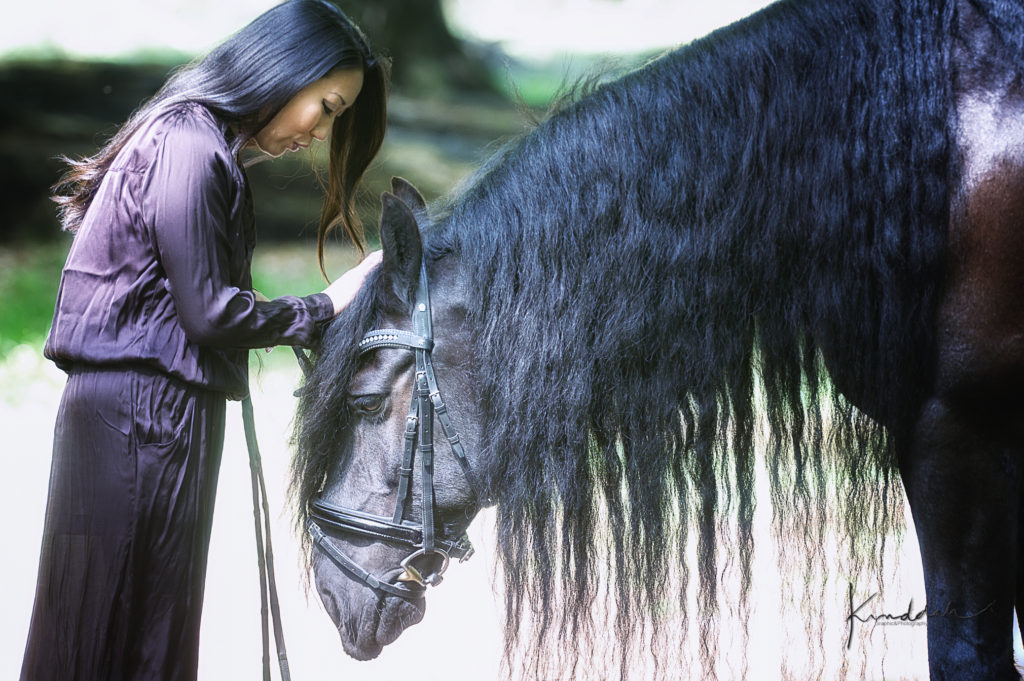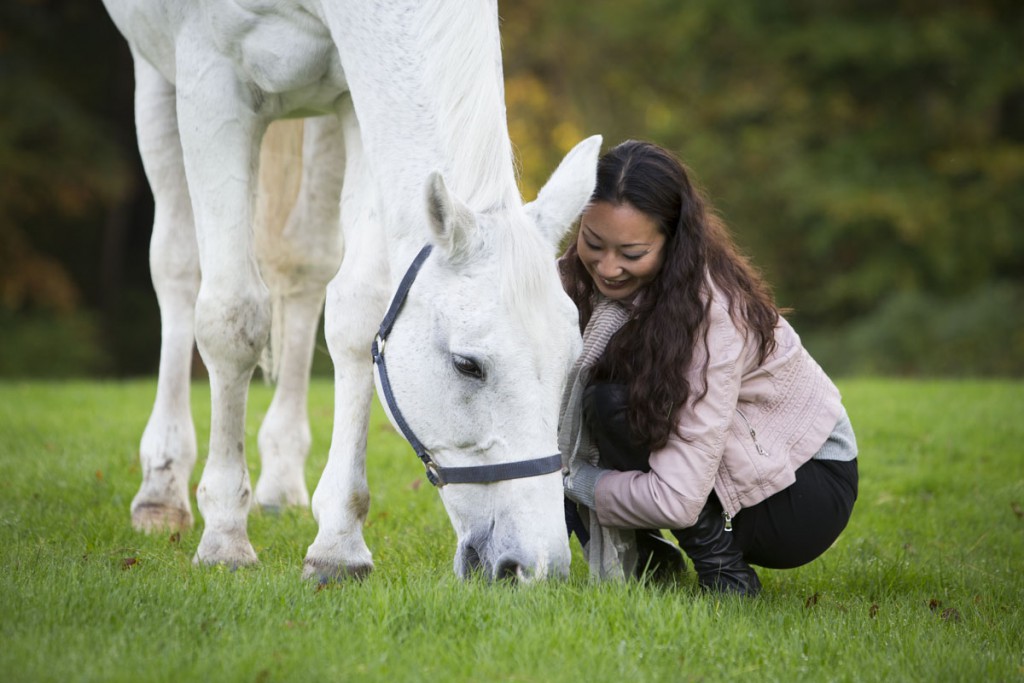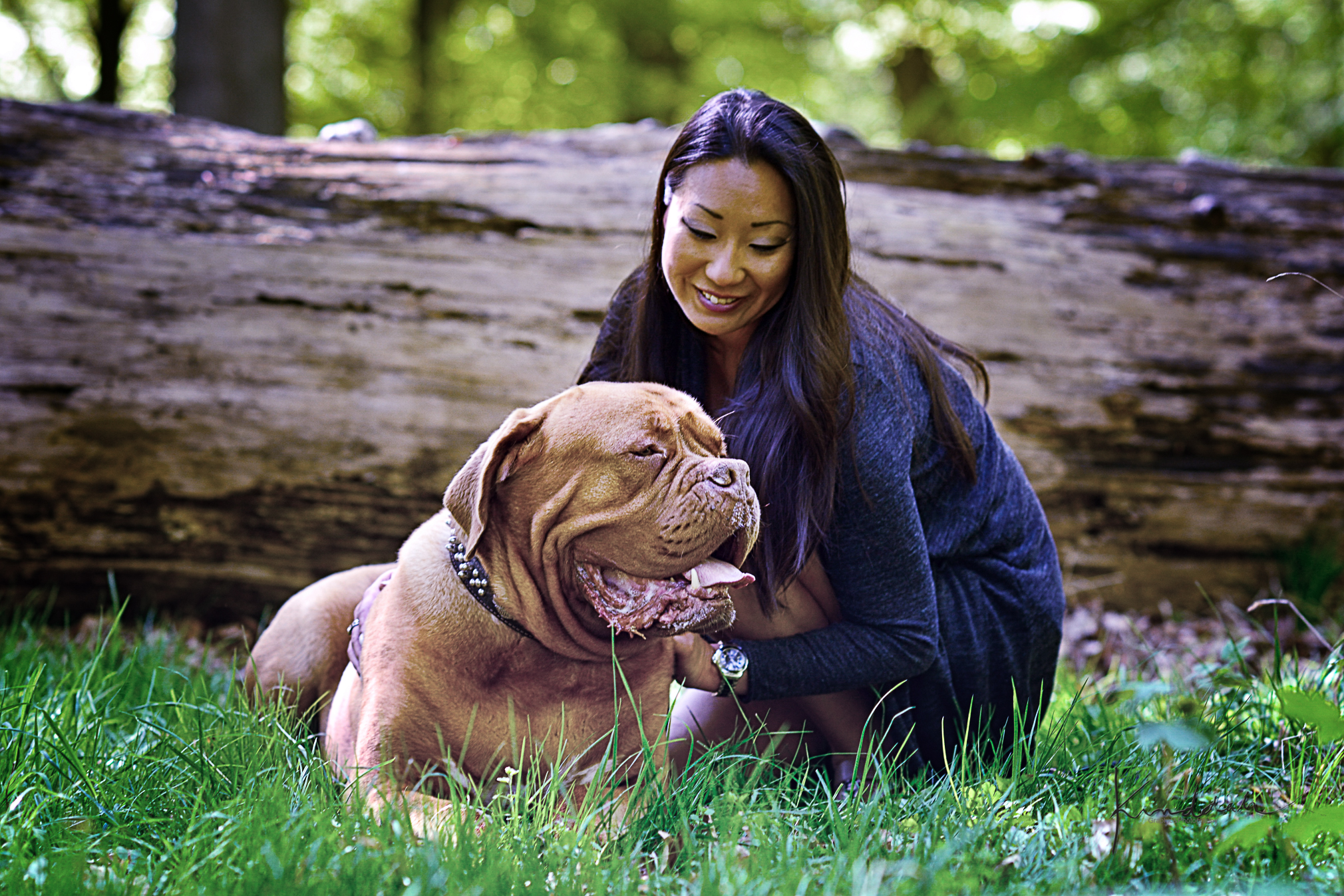What Is A Horse Whisperer?
Definition, Role & Education
by Ditte Young
Updated on October 3, 2023
Estimated reading time: 8 minutes
A horse whisperer is a person who can understand and communicate with horses through nonverbal communication.
Typically, horse whisperers are people who can calm horses and work with behavioral problems. This can take years to master, and often you become a horse whisperer by developing an innate sense of horses, dogs, and other types of animals.
In this article, you will learn more about what a horse whisperer is, what a horse whisperer’s role is when it comes to training and helping horses, and how you can become a horse whisperer.
Table of Contents
What is a horse whisperer?
The term “horse whisperer” means someone who can understand and communicate with horses through nonverbal communication.
Initially, a horse whisperer was called a horseman, coming from the word horsemanship. Today, the word explains how horse owners and riders can deal better with their horses.
Horse whisperers read and interpret the horse’s body language, facial expressions, and vocal tones, allowing them to understand, calm, train, and build trust with the horse. Some horse whisperers can also establish a telepathic connection with the horse and receive further nonverbal communication through mental images, thoughts and ideas, smells, tastes, and other sensations. This is what we know as Animal Communication or Animal Telepathy.
Equine euthology — the study of horse behavior in their natural environment — was born of a desire to help horses. This quest did not, however, require the invention of a new scientific field or the creation of a new discipline. Horse whispering is, in fact, a rediscovery of knowledge and experience accumulated over centuries and adapted to modern circumstances.
The survival and evolution of the horse have depended on its ability to defend itself against predators. The gap between predator and prey still exists, and any strange relationship between man and horse must be presented to the horse in a way that the horse can understand. Once this understanding has been established, everything becomes simple and possible. It can be summed up as follows: “Horses teach people so that people can teach horses.”




How does horse whispering work?
Horse whispering allows us to establish a stronger connection with our horses. This is important, as communicating with a horse requires mutual respect and trust to find the perfect balance between two souls trying to connect.
For a good relationship between the two, the horse needs to understand the signals from the human. This will help the horse feel comfortable and safe, deepening the partnership and connection between the horse and the human. A horse whisperer can facilitate this by helping develop a stronger relationship between the human being and the horse, allowing the horse to build trust faster.
The horse’s nature dictates everything a horse does. However, many riders and trainers still need to learn why horses behave in specific ways. Understanding horse behavior automatically improves the relationship between man and horse. This understanding is the basis of the bond that will develop between them.
Horse whispering can help riders and trainers better understand their horses’ behavior. The horse will react positively to the rider’s commands through whispering. This engenders confidence, a precise understanding of what is being asked of the horse, and respect for what the horse is asked to do.
This also helps to end misunderstandings and promote positive behavior. It is untrue that a horse acts against their rider; a horse works according to their nature when they do not understand what is being asked of them. The horse will begin to act in harmony with the rider through horse whispering.
What is the role of a horse whisperer?
The role of a horse whisperer is to take the lead on the partnership with the horse and create a safe environment for the horse to play, train, and be together with the rider in mutual respect.
There are many different techniques to train natural horse whispering. There are as many training techniques as equestrians; it depends on the individual horse whisperer’s body language, signals, and energies.
Horse whisperers who read the horse’s mind vary, too, because no two horse whisperers receive information in exactly the same way.
Typically, a horse whisperer will receive signals and pieces of information from the horse by:
- Reading the body language of the horse
- Reading the energy from the horse
- Receiving pictures or images in front of the inner eyes
- Receiving emotions based on extreme empathy
- Receiving physical symptoms from the horse, such as pain
- Being clairsentient and receiving clear psychic messages in their inner ear
Based on this information, the horse whisperer can read the horse better and understand what it needs to feel safe. The horse is an animal that, when socialized, wants to be with us; when the horse is safe, it will adapt, work, and play better with us as human beings.
The horse whisperer's role in training young horses
The sooner the young horse can read body language and know its body language, the more harmonic the connection and training will be from the beginning. All trainers who train young horses need to read the young horses’ body language and energy. Not all trainers do that, but they take them into the training and want fast results to sell the horse as fast as possible.
But modern equine psychology investigates how vital the first years of training horses are since the horse remembers the signals for the rest of its life. This makes horse whispering crucial to ease training and develop a genuine harmonic connection with the rider early on.
The horse whisperer's role in helping horses to overcome trauma
Horse whisperers are increasingly used to help horses overcome trauma. Most horse whisperers now understand that what is locked in the nervous system takes several years to unlock or unwind.
A horse whisperer is often used when facing behavioral issues or environmental problems with the horse.
This is particularly relevant if the horse is afraid of any of the following:
- Oncoming objects
- Vehicles or traffic
- Sounds
- The veterinarian
- Water
- The cutting machine
- The jumps
- The whip, saddle, boots, jackets, etc.
- Strangers
- The box
- Having a rider on its back
In the vast majority of cases, these problems are caused by trauma before training with the young horse or from a past where the previous owner didn’t feel understood. The horse whisperer can quickly screen the horse’s pattern and determine what the horse needs in the specific situation.
A horse whisperer’s role is to be objective
For a horse whisperer, being objective is key. A horse whisperer cannot succumb to emotions that the horse’s owner or rider would feel.
This means that the horse whisperer cannot react negatively to:
- Disappointment
- Lack of communication
- Feeling a lack of connection
- Experiencing a lack of emotions and the need for a match
- Feeling insecure around the horse
- Assumptions about the horse
- Bad experiences with the horse
A horse whisperer must rely on nonverbal communication and body language. The horse whisperer should always be aware of showing the horse what it needs to do instead of what we are afraid the horse might do. It should also go without saying that the horse whisperer cannot be abusive towards the horse.
As soon as the horse whisperer senses the horse’s personal space and teaches the horse to respect your personal space, regardless of the situation, then a new connection and bond can occur in a bubble where they can work and play together simultaneously.
The importance of a horse whisperer
As more and more riders and horse owners want to connect better with their horses, the role of the horse whisperer grows ever more critical.
For many people, the horse is far more than an animal companion to win medals, have experiences with, or chase a career in the equine industry. The horse is a true friend and, for many of us, more accessible than human beings.
The horse never requires anything; it is pure love, a soulmate, and a mirror of the horse owner. To understand horse psychology, you need to understand yourself. The professional horse whisperer can help you do just that.
The most important thing the horse whisperer can help you with is to understand that the horse works from:
- Its instincts
- Not holding any grudges against you
- Always cooperating if it is not in pain
- Showing you how to read its signals
A horse whisperer can teach you how to read the horse’s signals and send out clear signals of your own. This can deepen the connection between you and your horse, allowing you to create that special bubble for just the two of you whenever you need it.
When do I need a horse whisperer?
People often think about when they need a horse whisperer. Usually, they start by seeking help in the academic world — using their experienced horse trainers, veterinarians, or riding instructors.
Soon, they will figure out that a professional horse whisperer looks at the connection in a much more holistic way where both parties (the horse and the horse whisperer) need to align their energy field, read each other’s body language, and see the obvious signs in the horse.
None of the other experts do that as a necessity, which is why nonverbal communication impacts collaboration and heightens communication effectively.
I recommend seeking the help of a professional horse whisperer when you are interested in knowing:
- What your horse thinks
- The personality profile of your horse
- Your horse's behavioral patterns
- The difference between an experienced pain in the body and an insecure emotion
- Want to communicate effectively with the horse
- Want to practice and learn nonverbal communication forms
- Want practical experience in training young horses
- The cause behind a behavioral issue
- What signals you are sending out and how to take responsibility for them
The typical equine signals a horse whisper recognizes are:
- Stressed or distressed
- Anxious
- Suffering from trauma
- Misunderstanding your signals
- In pain
- Upset or frustrated
- Relaxed
- Showing you calming signals
The versatility of the ears
The ears are typically a good way to read the horse’s emotions. They also show if the body is straight during training or the rider is not sitting straight in the saddle.
The rider’s weight significantly impacts the horse more than many think. Remember that many sensitive horses react if a fly is sitting on them. Even though the horse is a big animal, it is still so sharp, so it responds to the tiniest thing on its body.
If the horse lays down its ears, it is typically a sign of frustration, anger, or insecurity. If the horse lays down one ear while riding horses, it is usually a sign that the rider is holding on too heavily on the rein on one side.
You can read so much nonverbally from the horse’s body language.
Horses’ calming signals include:
- Stretching down
- Licking lips
- Eating to calm themselves
- Yawning
- Having lateral ears
We know at least 30 calming signals that the animals use every day with each other. All calming signals are universal and widely used by most horses, regardless of the breed, age, or country in which the horse is living.
When I help riders or horse owners with signals, I always make them aware of the stress level in their horses. If it is growing, I always recommend stopping whatever we are doing. We pause, reconnect, and create a new bubble until the horse is fully relaxed. I practice the same method with traumatized horses and work with young horses to relax their nervous system.
Pawing with the hooves
Pawing is a signal of boredom, severe pain, or stress.
Many riders think it can be a behavioral problem, which it very well could be. But often, some horses do that to show dominance, nervousness, pain in an area, have experienced a trauma such as lack of food when it’s dinner time, or it can be a way to gain attention.
How do you become a horse whisperer?
If you want to become a horse whisperer and learn how to master telepathy with horses, and learn from the best and most recognized animal communicator and horse psychologist in Europe, now is your chance.
Yes! You can make a career path out of being an animal lover and helping humans to understand them better. I have trained more than 500 students worldwide, and 60 % of them are practicing animal communication as a profession today.
I have built bridges and made collaborations with:
- Riders
- Elite riders from all over the world
- Veterinarians
- Professional horse trainers
- Riding instructors
- Other professional horse whisperers
Because we all want the same thing: To heighten horse welfare, make the equine industry more harmonic, and increase the focus on every horse having a personality and a story to tell.
You don’t have to master any telepathic skills when you begin. I reassure you that telepathy is activated within 5 minutes.
However, practicing telepathy, being spot-on regarding health issues, and solving behavioral problems require more than that. They require your commitment, time, and interest in learning more about yourself and your abilities.
FAQ
Horse whispering has been a profession for many years. People such as Monty Roberts or Pat Parelli have made many classes for people interested in learning “old-fashioned” horsemanship.
In the more modern world, an experienced horse trainer or expert has made their techniques and found a method that works for both the rider and the horse.
Even when it comes to therapy with horses, many trainers use horsemanship or animal communication in their sessions to ensure the horse is calm with the clients. The word “Animal Telepathy” is becoming more common in many parts of the world.
The term “horse whispering” dates to nineteenth-century Europe when an Irish horseman, Daniel “Horse-Whisperer” Sullivan (d. 1810), made a name for himself in England by rehabilitating horses that had become vicious and intractable due to abuse or accidental trauma.
Natural horsemanship is a collective term for various horse training techniques that have grown rapidly in popularity since the 1980s.
The techniques vary in their precise tenets but generally share principles of “a kinder and gentler cowboy” to develop a rapport with horses, using methods said to be derived from observation of the natural behavior of free-roaming horses and rejecting abusive training methods.
Want to keep up with Ditte Young’s work?


